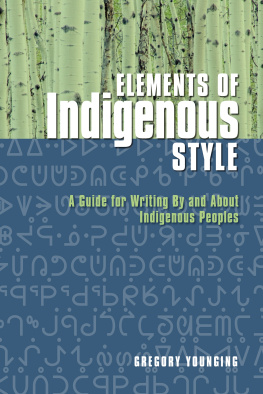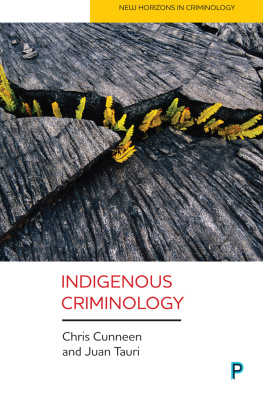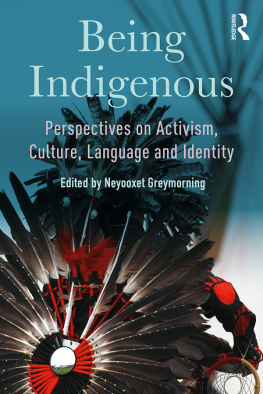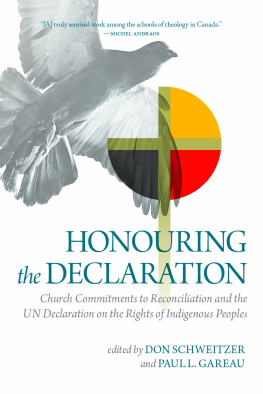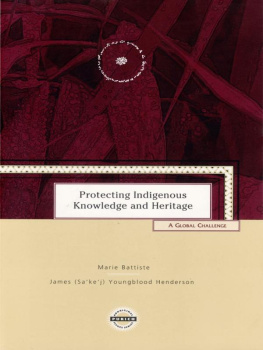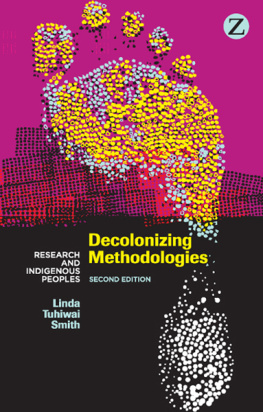Elements of Indigenous Style
A GUIDE FOR WRITING BY AND ABOUT INDIGENOUS PEOPLES
Gregory Younging

Copyright 2018 Gregory Younging
18 19 20 21 22 5 4 3 2 1
Printed and manufactured in Canada
Thank you for buying this book and for not copying, scanning, or distributing any part of it without permission. By respecting the spirit as well as the letter of copyright, you support authors and publishers, allowing them to continue to create and distribute the books you value.
Excerpts from this publication may be reproduced under licence from Access Copyright, or with the express written permission of Brush Education Inc., or under licence from a collective management organization in your territory. All rights are otherwise reserved, and no part of this publication may be reproduced, stored in a retrieval system, or transmitted in any form or by any means, electronic, mechanical, photocopying, digital copying, scanning, recording, or otherwise, except as specifically authorized.
Brush Education Inc.
www.brusheducation.ca
Cover image: istock: OGphoto
Cover and interior design: Carol Dragich, Dragich Design
Proofreading: Shauna Babiuk
Index: Stephen Ullstrom
Contributors
Mary Cardinal Collins
Warren Cariou
Sophie McCall
Library and Archives Canada Cataloguing in Publication
Younging, Gregory, author
Elements of Indigenous style : a guide for writing by and about Indigenous Peoples / Gregory Younging.
Includes bibliographical references and index.
Issued in print and electronic formats. ISBN 978-1-55059-716-5 (softcover).--ISBN 978-1-55059-717-2 (PDF).--ISBN 978-1-55059-718-9 (Kindle).--ISBN 978-1-55059-719-6 (EPUB)
1. Authorship--Style manuals. 2. Authorship--Handbooks, manuals, etc. 3. Native authors--Canada. 4. Native peoples in literature. 5. Ethnography--Authorship--Style manuals. I. Title.
PN147.Y68 2018808.02C2017-908038-5
C2017-908039-3

Indigenous peoples have the right to maintain, control, protect and develop their cultural heritage, traditional knowledge and traditional cultural expressions, as well as the manifestations of their sciences, technologies and cultures, including human and genetic resources, seeds, medicines, knowledge of the properties of fauna and flora, oral traditions, literatures, designs, sports and traditional games and visual and performing arts. They also have the right to maintain, control, protect and develop their intellectual property over such cultural heritage, traditional knowledge, and traditional cultural expressions.
Article 31, United Nations Declaration on the Rights of Indigenous Peoples, 2007
Foreword
This book is an extremely important, timely, and well-thought-out resource. It is an excellent guide for publishers, academics, journalists, students, and anyone else who is interested in writing about Indigenous Peoples. Greg Youngings extraordinary experience, cultural sensitivity, and knowledge base come through on every page, providing readers with very thoughtful and helpful advice on so many areas of potential difficulty. I can see that this book will have very wide relevance even beyond Canadas borders, though it is well focused on the Canadian context.
The book is written in an eloquent, intimate style that puts readers at ease and positions them as participants in a conversationa technique that works exceedingly well for the chosen purpose. There is a great need for a resource of this kind, and Elements of Indigenous Style fits that need in a resoundingly positive and productive way. Over time, I feel that this book will make a significant difference in the fair and equitable representation of Indigenous Peoples, and this will lead to empowerment and pride among Indigenous community members.
In addition to the invaluable advice contained in the books editorial principles, the word-usage examples are extremely helpful. The discussion of rights, intellectual property, and the public domain is excellent, as is the material on Mtis identity and community history. Throughout the book, the discussion of problematic practices is done in a clear and thoughtful way, explaining why a particular practice is disrespectful or inaccurate. Thus, it comes across not as a prescriptive and authoritarian book (as some writing textbooks do), but rather as a teaching text that informs readers of why certain editorial practices are problematic, and how these situations can be avoided. This book provides solutions rather than solely identifying problems.
Possibly the most important ethos of this book is contained in the advice that there is no substitute for engaging in a relationship with the Indigenous Peoples who are represented in a text. This book foregrounds the Indigenous methodology of working from the basis of relationships, and thus it is an excellent example of decolonial scholarship.
Warren Cariou
Canada Research Chair in Narrative, Community, and Indigenous Cultures
Director, Centre for Creative Writing and Oral Culture
Professor, Department of English, Film, and Theatre
University of Manitoba
Preface
This book represents the first published editorial principles and guidelines for works written by or about Indigenous Peoples. I am not putting these principles and guidelines forward as quintessential. This book is, indeed, a first attempt at an Indigenous style guide and a first volume. I fully intend that Indigenous and non-Indigenous publishers and editors, and other interested parties, will consider these as proposed principles and guidelines, and provide feedback that will inform subsequent editions.
Some elements of a higher level of authenticity in Indigenous works are currently in a state of evolution and flux, such that a comprehensive style guide is not yet possible. Heres an example: we are in an era when Indigenous Nations are rejecting the colonial names that have been applied to and imposed on them, and are reclaiming their original names. Inuit were among the first to reject the term Eskimo in the 1970s; since then, many Indigenous Peoples have been bringing the word their ancestors called themselves back into use.
This phenomenon is occurring across the continent, hemisphere, and world, but not with any degree of consistency. In addition, in some cases, a range of spellings exists for some of these original names.
Consequently, with this and some other issues in the following chapters, I have attempted to state best current practices and I hope that more comprehensive solutions will be developed in future editions of this book or in future work by others. I am also fully open to critique on the propositions I am making in this book and to considering other arguments and opinions, which Im sure will lead to improvements in subsequent volumes. As this book is published, The Chicago Manual of Style is in its seventeenth edition, and I hope there will be many editions of this Indigenous style guide as well.
I am not the sole authority, but merely someone who has been working on these issues and has been encouraged to put the first Indigenous style guide out there for consideration. Still, I am confident that this guide will be useful to editors and publishers, and that it has the potential to lead to better works by and about Indigenous Peoples. I hope you will at least find it as interesting and thought provoking as I have.

